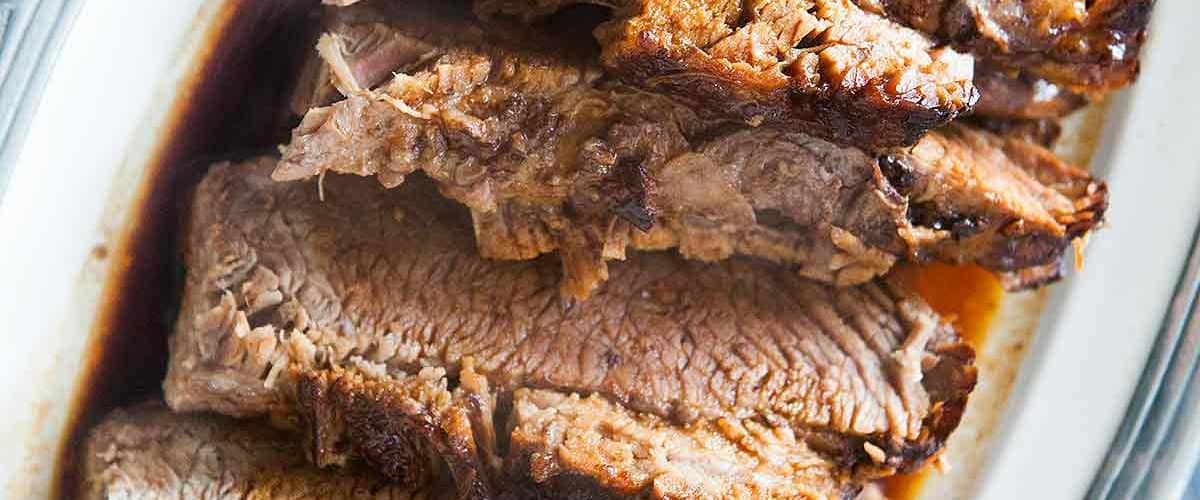For the inexperienced home cook, cooking a large piece of meat in the oven that will be the centerpiece of a family meal can be an intimidating experience. Fortunately, certain cuts of meat are easier to cook than others and can produce fantastic results that are sure to be well received by every guest. One cut of meat that is particularly easy to cook and almost foolproof is beef brisket.
Home cooks often have problems with cooking roasts because they frequently overcook the meats, resulting in dry, tough, and flavorless meals. Overcooking and dryness is a particular problem when roasting chicken or pork, both of which can turn from moist and succulent, to dry and leathery in a matter of minutes. Beef roasts contain much more fat than either pork or chicken and give the home cook a larger margin of error for overcooking because the extra fat keeps the meat moist and juicy. Some cuts of beef are still prone to overcooking, like rib roasts and steaks, but other cuts like chuck and brisket are more suitable to longer cooking methods.
Brisket and Braising
Different cuts of beef have different cooking characteristics. Some cuts of meat are tender and devoid of intramuscular connective tissues like strip steaks and tenderloin. These cuts of beef are best suited to quick cooking methods and can be served rare. Other cuts of beef like the brisket contain much more connective tissue in the form of collagen and gelatin, which can make them tough. The brisket is a cut of beef that comes from the lower breast of the cow, beneath the front shoulders. Because they contain so much connective tissue, beef briskets require a long cooking time in a moist environment to break down the collagen and gelatin in order to produce a tender and moist cut of meat. Brisket is a flavorful cut of beef, but requires a long cooking time.
The best cooking method for cooking brisket is braising. Braising is a technique in which a tough piece of meat is simmered for a long time in a flavorful liquid. During the braising process, tough connective tissues are dissolved, rendering the meat tender and succulent. Braising a beef brisket is a relatively hands free process, requiring only a few minutes of preparation. The cooking time is long, but requires practically no attention from the cook.
Buying the Brisket
Beef brisket is a large cut of meat that will feed several people. When purchasing a beef brisket, select one that is between 7-10 pounds to feed between 10 and 12 people. This may seem like a lot of meat, but during the cooking time, the roast shrinks considerably. You will want to choose a brisket that has its fat cap on. The fat cap is a thin layer of fat that covers one side of the brisket. The fat cap will add extra moisture and flavor, while also acting as an automatic baster as the fat melts and drips over the brisket.
Cooking the Brisket
1. Preheat an oven to 350 degrees.
2. Season a beef brisket liberally with salt, pepper, minced, fresh garlic and dried oregano.
3. Place the seasoned meat into a large, heavy roasting pan or into a Dutch oven.
4. Slice 2 large onions, 5 carrots, and 4 ribs of celery into large chunks.
5. Place the vegetables around the brisket into the pan.
6. Cover the brisket with tomato juice till the liquid comes 3/4 of the way up the side of the meat.
7. Cover the brisket with parchment paper and then tightly seal the pan with aluminum foil.
8. Bake in the oven for 4-5 hours depending on the size of the brisket. To test to see if the brisket is cooked, insert a fork into the thickest part of the brisket. If the fork comes out easily with no resistance, the meat is done.
9. Remove the brisket to a serving dish and tent loosely with foil. Allow it to rest for at least 30 minutes before carving.
10. Meanwhile, place the roasting pan directly onto the stove and bring the liquid to a boil. Allow the sauce to reduce in order to concentrate the flavors.
11. Once the desired consistency and flavor is reached, remove the sauce from the stove and strain out the vegetables.
12. Arrange the vegetables onto a serving platter and slice the brisket into thin strips, taking care to cut against the grain.
13. Serve the sauce along the side.
<>



